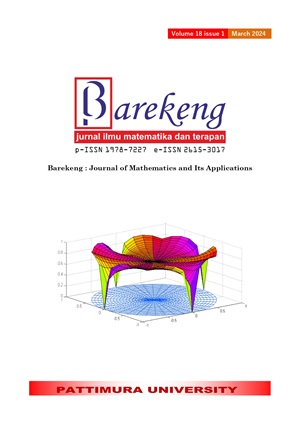WEIBULL-POISSON DISTRIBUTION AND THEIR APPLICATION TO SYSTEMATIC PARALLEL RISK
Abstract
The Weibull-Poisson distribution represents a continuous distribution type applicable to various forms of hazard, including monotone up, monotone down, and upside-down bathtub shapes that ascend. The distribution characterizes lifetimes and can effectively model failures within a series of systems, which evolves from the Exponential-Poisson distribution. This distribution emerges through the compounding of the Weibull Distribution and Zero Truncated Poisson Distribution. The compounding itself integrates several mathematical properties, such as statistical order and Taylor’s number expansion, to reach its final form. Alongside the formulation of the Weibull-Poisson distribution, this paper includes the probability density function, distribution function, rth moment, rth central moment, mean, and variance. For illustration, the Weibull-Poisson distribution is applied to guinea pig survival data after being infected with Turblece virus Bacilli.
Downloads
References
S. L. K. Adamidis, "A lifetime distribution with decreasing failure rate," Statistics & Probability Letters, pp. 35-42, 1998.
F. C.-N. Wagner Barreto-Souza, "A generalization of the exponential-Poisson distribution," Statistics & Probability Letters, pp. 2493-2500, 2009.
S. R. Rasool Tahmasbi, "A two-parameter lifetime distribution with decreasing failure rate," Computational Statistics & Data Analysis, pp. 3889-3901, 2008.
W. Barreto-Souza, A. L. d. Morais and G. M. Cordeiro, "The Weibull-geometric distribution," Journal of Statistical Computation and Simulation, pp. 645-657, 2011.
V. P. Roxana Ciumara, "The Weibull-Logarithmic Distribution in Lifetime Analysis and It's Properties," ASMDA. Proceedings of the International Conference Applied Stochastic Models and Data Analysis, p. 395, 2009.
D. S. Wanbo Lu, "A new compounding life distribution: the Weibull–Poisson distribution," Journal of Applied Statistics, pp. 21-38, 2012.
T. Bjerkedal, "Acquisition of Resistance in Guinea Pies infected with Different Doses of Virulent Tubercle Bacilli," American Journal of Hygiene, pp. 130-148, 1960.
V. P. K. A. Sotirios Loukas, "A Generalization of the Exponential-Logarithmic Distribution," Journal of Statistical Theory and Practice, p. 395, 2009.
J. W. M. A. T. C. Robert V. Hogg, Introduction to Mathematical Statistics, 2019.
R. L. Burden, J. D. Faires, and A. M. Burden, Numerical Analysis, 10th ed. Singapore: Cengage Learning Asia Pte Ltd, 2015.
W. J. Conover, Practical Nonparametric Statistics. New York City, New York: Wiley, 1999.
D C M Dickson, M. Hardy, and H. R. Waters, Actuarial mathematics for life contingent risks. New York: Cambridge University Press, 2013.
R. E. Glaser, "Bathtub and Related Failure Rate Characterizations," Journal of the American Statistical Association, pp. 667-672, 1980.
M. K. David G. Kleinbaum, Survival Analysis: A Self-Learning Text. United State: Springer, 2005.
H. H. P. G. E. W. Stuart A. Klugman, Loss models: from data to decisions. United State: John Wiley & Sons, 2012.
Copyright (c) 2024 Rugun Ivana, Yekti Widyaningsih

This work is licensed under a Creative Commons Attribution-ShareAlike 4.0 International License.
Authors who publish with this Journal agree to the following terms:
- Author retain copyright and grant the journal right of first publication with the work simultaneously licensed under a creative commons attribution license that allow others to share the work within an acknowledgement of the work’s authorship and initial publication of this journal.
- Authors are able to enter into separate, additional contractual arrangement for the non-exclusive distribution of the journal’s published version of the work (e.g. acknowledgement of its initial publication in this journal).
- Authors are permitted and encouraged to post their work online (e.g. in institutional repositories or on their websites) prior to and during the submission process, as it can lead to productive exchanges, as well as earlier and greater citation of published works.






1.gif)



